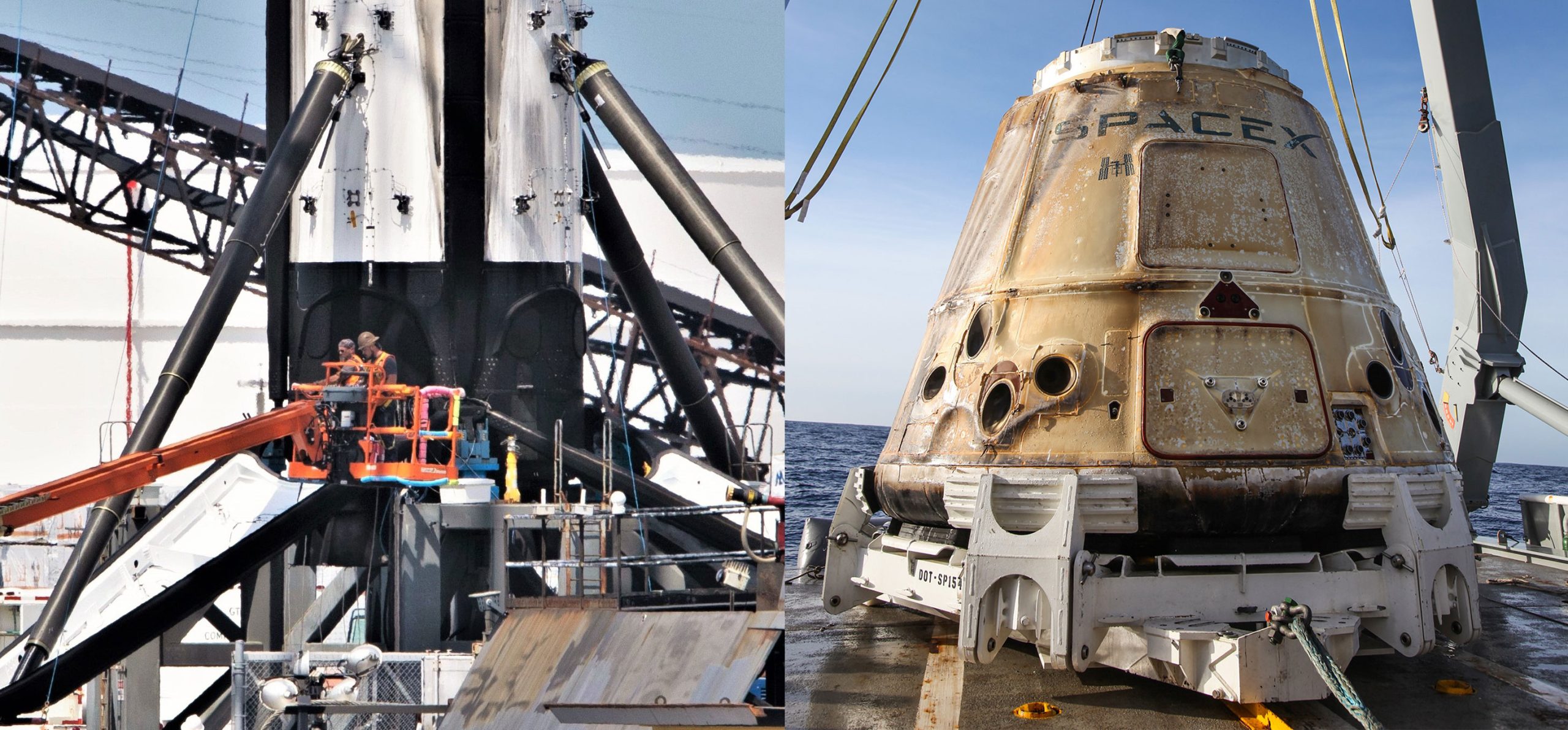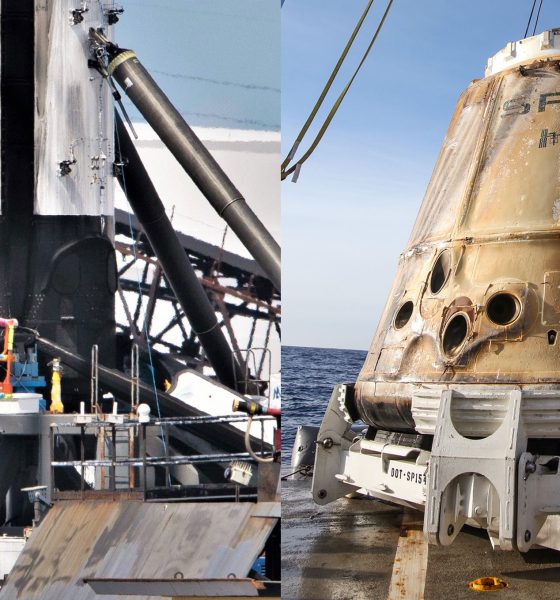

News
SpaceX set to deliver cargo to the space station with a twice-flown Dragon spacecraft
SpaceX is set to become the only company in history to launch the same commercial space capsule to orbit three times, a milestone of orbital spacecraft reuse in an otherwise ‘routine’ Cargo Dragon mission to the International Space Station (ISS).
Known as CRS-18, the mission will (hopefully) see Cargo Dragon capsule C108 and a fresh trunk deliver several tons of cargo to the ISS, SpaceX’s second of three such launches planned for 2019. Beyond Cargo Dragon’s third trip to orbit, building upon SpaceX’s inaugural commercial spacecraft reuse back in June 2017, Falcon 9 B1056.1 will become the first flight-proven Block 5 booster to launch a NASA mission, potentially setting the particular core up for many more NASA reuses to come. CRS-18 is scheduled to launch no earlier than (NET) 6:24 pm EDT (21:24 UTC), July 24th.
SpaceX reused one of its Cargo Dragon (Dragon 1) capsules for the first time in June 2017, becoming the first company in history to recover and reuse an orbital-class spacecraft, much like the company is about to become the first to reuse a commercial spacecraft twice. Speaking at the ISSR&D 2017 conference, SpaceX CEO Elon Musk noted that – despite the fact that it was the first time a commercial entity (including SpaceX) had reused an orbital spacecraft – the cost of refurbishing Cargo Dragon C106 was no less than 50% cheaper than building a new capsule.
The cost-effectiveness of Cargo Dragon reuse has likely only improved in the two years since that historic first, meaning that SpaceX’s ISS resupply runs likely feature some extremely healthy margins for the company. According to an exhaustive 2017 analysis of CRS costs, the total cost of a single Cargo Dragon resupply mission is likely ~$175M (FY19). (Zapata, 2017)

Aside from CRS-18, SpaceX has two Dragon 1 launches remaining in its original CRS1 contract with NASA. Both will also necessarily make use of twice-flown capsules like CRS-18, leaving SpaceX with a retired fleet of no fewer than three thrice-flown and three twice-flown orbital spacecraft as Dragon 2 (Crew Dragon) takes the reins. Current schedules show SpaceX’s final CRS1 launch – CRS-20 – following CRS-19 (NET December 2019) in March 2020. Cargo Dragon 2’s launch debut is currently scheduled no earlier than August 2020 and – as all Cargo Dragon 2 launches – will reuse a lightly-modified, orbit-proven Crew Dragon capsule.
CRS-18: bad weather in spades
CRS-18 will likely face some of the worst weather SpaceX has ever experienced during an attempted Falcon 9 launch, with July 24th and the July 25th backup window carrying probabilities of violation (i.e. a scrub) of 70% and 80%, respectively. In other words, there is a measly 30% and 20% chance that Falcon 9 will be able to launch CRS-18 this Wednesday or Thursday.
Supporting the Cargo Dragon launch is Falcon 9 booster B1056.2, likely to set the second-fastest Falcon 9 turnaround time with just 80 days between its May 4th launch debut and CRS-18. SpaceX’s turnaround record currently stands at 74 days – a three-way tie between boosters B1048, B1052, and B1053. Additionally, B1056’s second launch will also mark the first time that NASA has reused a Block 5 booster, an important indication that the space agency is extremely comfortable with SpaceX’s latest Falcon 9 variant and its associated reuse procedures.
Stay tuned as Falcon 9 prepares to go vertical at Cape Canaveral Launch Complex 40 (LC-40) and the Air Force Station’s final T-24h launch day weather forecasts begin to roll in
Check out Teslarati’s Marketplace! We offer Tesla accessories, including for the Tesla Cybertruck and Tesla Model 3.

News
Tesla FSD fleet is nearing 7 billion total miles, including 2.5 billion city miles
As can be seen on Tesla’s official FSD webpage, vehicles equipped with the system have now navigated over 6.99 billion miles.

Tesla’s Full Self-Driving (Supervised) fleet is closing in on almost 7 billion total miles driven, as per data posted by the company on its official FSD webpage.
These figures hint at the massive scale of data fueling Tesla’s rapid FSD improvements, which have been quite notable as of late.
FSD mileage milestones
As can be seen on Tesla’s official FSD webpage, vehicles equipped with the system have now navigated over 6.99 billion miles. Tesla owner and avid FSD tester Whole Mars Catalog also shared a screenshot indicating that from the nearly 7 billion miles traveled by the FSD fleet, more than 2.5 billion miles were driven inside cities.
City miles are particularly valuable for complex urban scenarios like unprotected turns, pedestrian interactions, and traffic lights. This is also the difference-maker for FSD, as only complex solutions, such as Waymo’s self-driving taxis, operate similarly on inner-city streets. And even then, incidents such as the San Francisco blackouts have proven challenging for sensor-rich vehicles like Waymos.
Tesla’s data edge
Tesla has a number of advantages in the autonomous vehicle sector, one of which is the size of its fleet and the number of vehicles training FSD on real-world roads. Tesla’s nearly 7 billion FSD miles then allow the company to roll out updates that make its vehicles behave like they are being driven by experienced drivers, even if they are operating on their own.
So notable are Tesla’s improvements to FSD that NVIDIA Director of Robotics Jim Fan, after experiencing FSD v14, noted that the system is the first AI that passes what he described as a “Physical Turing Test.”
“Despite knowing exactly how robot learning works, I still find it magical watching the steering wheel turn by itself. First it feels surreal, next it becomes routine. Then, like the smartphone, taking it away actively hurts. This is how humanity gets rewired and glued to god-like technologies,” Fan wrote in a post on X.
News
Tesla starts showing how FSD will change lives in Europe
Local officials tested the system on narrow country roads and were impressed by FSD’s smooth, human-like driving, with some calling the service a game-changer for everyday life in areas that are far from urban centers.

Tesla has launched Europe’s first public shuttle service using Full Self-Driving (Supervised) in the rural Eifelkreis Bitburg-Prüm region of Germany, demonstrating how the technology can restore independence and mobility for people who struggle with limited transport options.
Local officials tested the system on narrow country roads and were impressed by FSD’s smooth, human-like driving, with some calling the service a game-changer for everyday life in areas that are far from urban centers.
Officials see real impact on rural residents
Arzfeld Mayor Johannes Kuhl and District Administrator Andreas Kruppert personally tested the Tesla shuttle service. This allowed them to see just how well FSD navigated winding lanes and rural roads confidently. Kruppert said, “Autonomous driving sounds like science fiction to many, but we simply see here that it works totally well in rural regions too.” Kuhl, for his part, also noted that FSD “feels like a very experienced driver.”
The pilot complements the area’s “Citizen Bus” program, which provides on-demand rides for elderly residents who can no longer drive themselves. Tesla Europe shared a video of a demonstration of the service, highlighting how FSD gives people their freedom back, even in places where public transport is not as prevalent.
What the Ministry for Economic Affairs and Transport says
Rhineland-Palatinate’s Minister Daniela Schmitt supported the project, praising the collaboration that made this “first of its kind in Europe” possible. As per the ministry, the rural rollout for the service shows FSD’s potential beyond major cities, and it delivers tangible benefits like grocery runs, doctor visits, and social connections for isolated residents.
“Reliable and flexible mobility is especially vital in rural areas. With the launch of a shuttle service using self-driving vehicles (FSD supervised) by Tesla in the Eifelkreis Bitburg-Prüm, an innovative pilot project is now getting underway that complements local community bus services. It is the first project of its kind in Europe.
“The result is a real gain for rural mobility: greater accessibility, more flexibility and tangible benefits for everyday life. A strong signal for innovation, cooperation and future-oriented mobility beyond urban centers,” the ministry wrote in a LinkedIn post.
News
Tesla China quietly posts Robotaxi-related job listing
Tesla China is currently seeking a Low Voltage Electrical Engineer to work on circuit board design for the company’s autonomous vehicles.

Tesla has posted a new job listing in Shanghai explicitly tied to its Robotaxi program, fueling speculation that the company is preparing to launch its dedicated autonomous ride-hailing service in China.
As noted in the listing, Tesla China is currently seeking a Low Voltage Electrical Engineer to work on circuit board design for the company’s autonomous vehicles.
Robotaxi-specific role
The listing, which was shared on social media platform X by industry watcher @tslaming, suggested that Tesla China is looking to fill the role urgently. The job listing itself specifically mentions that the person hired for the role will be working on the Low Voltage Hardware team, which would design the circuit boards that would serve as the nervous system of the Robotaxi.
Key tasks for the role, as indicated in the job listing, include collaboration with PCB layout, firmware, mechanical, program management, and validation teams, among other responsibilities. The role is based in Shanghai.
China Robotaxi launch
China represents a massive potential market for robotaxis, with its dense urban centers and supportive policies in select cities. Tesla has limited permission to roll out FSD in the country, though despite this, its vehicles have been hailed as among the best in the market when it comes to autonomous features. So far, at least, it appears that China supports Tesla’s FSD and Robotaxi rollout.
This was hinted at in November, when Tesla brought the Cybercab to the 8th China International Import Expo (CIIE) in Shanghai, marking the first time that the autonomous two-seater was brought to the Asia-Pacific region. The vehicle, despite not having a release date in China, received a significant amount of interest among the event’s attendees.








